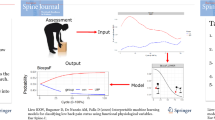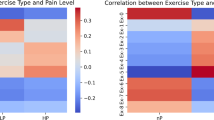Abstract
Low back pain (LBP) is the most significant contributor to years lived with disability in Europe and results in significant financial cost to European economies. Guidelines for the management of LBP have self-management at their cornerstone, where patients are advised against bed rest, and to remain active. In this paper, we introduce SELFBACK, a decision support system used by the patients themselves to improve and reinforce self-management of LBP. SELFBACK uses activity recognition from wearable sensors in order to automatically determine the type and level of activity of a user. This is used by the system to automatically determine how well users adhere to prescribed physical activity guidelines. Important parameters of an activity recognition system include windowing, feature extraction and classification. The choices of these parameters for the SELFBACK system are supported by empirical comparative analyses which are presented in this paper. In addition, two approaches are presented for detecting step counts for ambulation activities (e.g. walking and running) which help to determine activity intensity. Evaluation shows the SELFBACK system is able to distinguish between five common daily activities with 0.9 macro-averaged F1 and detect step counts with 6.4 and 5.6 root mean squared error for walking and running respectively.
Access this chapter
Tax calculation will be finalised at checkout
Purchases are for personal use only
Similar content being viewed by others
Notes
- 1.
The SELFBACK project is funded by the European Union’s Horizon 2020 research and innovation programme under grant agreement No 689043.
- 2.
Code and data associated with this paper are accessible from https://github.com/selfback/activity-recognition.
- 3.
References
Abel, M., Hannon, J., Mullineaux, D., Beighle, A., et al.: Determination of step rate thresholds corresponding to physical activity intensity classifications in adults. J. Phys. Activity Health 8(1), 45–51 (2011)
Ahanathapillai, V., Amor, J.D., Goodwin, Z., James, C.J.: Preliminary study on activity monitoring using an android smart-watch. Healthc. Technol. Lett. 2(1), 34–39 (2015)
Airaksinen, O., Brox, J., Cedraschi, C.O., Hildebrandt, J., Klaber-Moffett, J., Kovacs, F., Mannion, A., Reis, S., Staal, J., Ursin, H., et al.: Chapter 4 european guidelines for the management of chronic nonspecific low back pain. Eur. Spine J. 15, s192–s300 (2006)
Bao, L., Intille, S.S.: Activity recognition from user-annotated acceleration data. In: Pervasive Computing, pp. 1–17. Springer (2004)
Buchbinder, R., Blyth, F., March, L., Brooks, P., Woolf, A., Hoy, D.: Placing the global burden of low back pain in context. Best Pract. Res. Clin. Rheumatol. 27, 575–589 (2013)
Choi, B.C., Pak, A.W., Choi, J.C.: Daily step goal of 10,000 steps: a literature review. Clin. Investig. Med. 30(3), 146–151 (2007)
Dagenais, S., Caro, J., Haldeman, S.: A systematic review of low back pain cost of illness studies in the united states and internationally. Spine J. 8(1), 8–20 (2008)
Figo, D., Diniz, P.C., Ferreira, D.R., Cardoso, J.M.: Preprocessing techniques for context recognition from accelerometer data. Pers. Ubiquit. Comput. 14(7), 645–662 (2010)
Gao, L., Bourke, A., Nelson, J.: Evaluation of accelerometer based multi-sensor versus single-sensor activity recognition systems. Med. Eng. Phys. 36(6), 779–785 (2014)
He, Z., Jin, L.: Activity recognition from acceleration data based on discrete consine transform and svm. In: Systems, Man and Cybernetics, 2009. SMC 2009. IEEE International Conference on, pp. 5041–5044. IEEE (2009)
Jordan, K.P., Kadam, U.T., Hayward, R., Porcheret, M., Young, C., Croft, P.: Annual consultation prevalence of regional musculoskeletal problems in primary care: an observational study. BMC Musculoskelet. Disord. 11(1), 1 (2010)
Kent, P.M., Keating, J.L.: The epidemiology of low back pain in primary care. Chiropractic Osteopathy 13(1), 1 (2005)
Lara, O.D., Labrador, M.A.: A survey on human activity recognition using wearable sensors. IEEE Commun. Surv. Tutorials 15(3), 1192–1209 (2013)
Mannini, A., Intille, S.S., Rosenberger, M., Sabatini, A.M., Haskell, W.: Activity recognition using a single accelerometer placed at the wrist or ankle. Med. Sci. Sports Exerc. 45(11), 2193 (2013)
Mäntyjärvi, J., Himberg, J., Seppänen, T.: Recognizing human motion with multiple acceleration sensors. In: 2001 IEEE International Conference on Systems, Man, and Cybernetics, vol. 2, pp. 747–752. IEEE (2001)
Maurer, U., Smailagic, A., Siewiorek, D.P., Deisher, M.: Activity recognition and monitoring using multiple sensors on different body positions. In: International Workshop on Wearable and Implantable Body Sensor Networks. BSN 2006, pp. 4–pp. IEEE (2006)
Shoaib, M., Bosch, S., Incel, O.D., Scholten, H., Havinga, P.J.: Fusion of smartphone motion sensors for physical activity recognition. Sensors 14(6), 10146–10176 (2014)
Tapia, E.M., Intille, S.S., Haskell, W., Larson, K., Wright, J., King, A., Friedman, R.: Real-time recognition of physical activities and their intensities using wireless accelerometers and a heart rate monitor. In: 2007 11th IEEE International Symposium on Wearable Computers, pp. 37–40. IEEE (2007)
Zheng, Y., Wong, W.K., Guan, X., Trost, S.: Physical activity recognition from accelerometer data using a multi-scale ensemble method. In: IAAI (2013)
Author information
Authors and Affiliations
Corresponding author
Editor information
Editors and Affiliations
Rights and permissions
Copyright information
© 2016 Springer International Publishing AG
About this paper
Cite this paper
Sani, S., Wiratunga, N., Massie, S., Cooper, K. (2016). SELFBACK—Activity Recognition for Self-management of Low Back Pain. In: Bramer, M., Petridis, M. (eds) Research and Development in Intelligent Systems XXXIII. SGAI 2016. Springer, Cham. https://doi.org/10.1007/978-3-319-47175-4_21
Download citation
DOI: https://doi.org/10.1007/978-3-319-47175-4_21
Published:
Publisher Name: Springer, Cham
Print ISBN: 978-3-319-47174-7
Online ISBN: 978-3-319-47175-4
eBook Packages: Computer ScienceComputer Science (R0)




